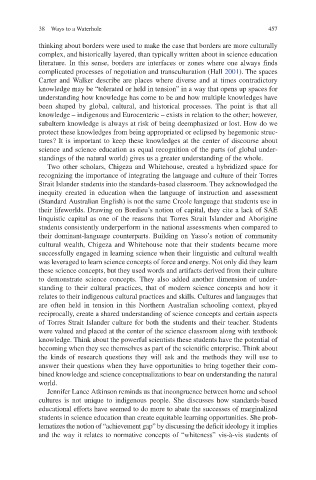Page 482 - Cultural Studies of Science Education
P. 482
38 Ways to a Waterhole 457
thinking about borders were used to make the case that borders are more culturally
complex, and historically layered, than typically written about in science education
literature. In this sense, borders are interfaces or zones where one always finds
complicated processes of negotiation and transculturation (Hall 2001). The spaces
Carter and Walker describe are places where diverse and at times contradictory
knowledge may be “tolerated or held in tension” in a way that opens up spaces for
understanding how knowledge has come to be and how multiple knowledges have
been shaped by global, cultural, and historical processes. The point is that all
knowledge – indigenous and Eurocenteric – exists in relation to the other; however,
subaltern knowledge is always at risk of being deemphasized or lost. How do we
protect these knowledges from being appropriated or eclipsed by hegemonic struc-
tures? It is important to keep these knowledges at the center of discourse about
science and science education as equal recognition of the parts (of global under-
standings of the natural world) gives us a greater understanding of the whole.
Two other scholars, Chigeza and Whitehouse, created a hybridized space for
recognizing the importance of integrating the language and culture of their Torres
Strait Islander students into the standards-based classroom. They acknowledged the
inequity created in education when the language of instruction and assessment
(Standard Australian English) is not the same Creole language that students use in
their lifeworlds. Drawing on Bordieu’s notion of capital, they cite a lack of SAE
linquistic capital as one of the reasons that Torres Strait Islander and Aborigine
students consistently underperform in the national assessments when compared to
their dominant-language counterparts. Building on Yasso’s notion of community
cultural wealth, Chigeza and Whitehouse note that their students became more
successfully engaged in learning science when their linguistic and cultural wealth
was leveraged to learn science concepts of force and energy. Not only did they learn
these science concepts, but they used words and artifacts derived from their culture
to demonstrate science concepts. They also added another dimension of under-
standing to their cultural practices, that of modern science concepts and how it
relates to their indigenous cultural practices and skills. Cultures and languages that
are often held in tension in this Northern Australian schooling context, played
reciprocally, create a shared understanding of science concepts and certain aspects
of Torres Strait Islander culture for both the students and their teacher. Students
were valued and placed at the center of the science classroom along with textbook
knowledge. Think about the powerful scientists these students have the potential of
becoming when they see themselves as part of the scientific enterprise. Think about
the kinds of research questions they will ask and the methods they will use to
answer their questions when they have opportunities to bring together their com-
bined knowledge and science conceptualizations to bear on understanding the natural
world.
Jennifer Lance Atkinson reminds us that incongruence between home and school
cultures is not unique to indigenous people. She discusses how standards-based
educational efforts have seemed to do more to abate the successes of marginalized
students in science education than create equitable learning opportunities. She prob-
lematizes the notion of “achievement gap” by discussing the deficit ideology it implies
and the way it relates to normative concepts of “whiteness” vis-à-vis students of

